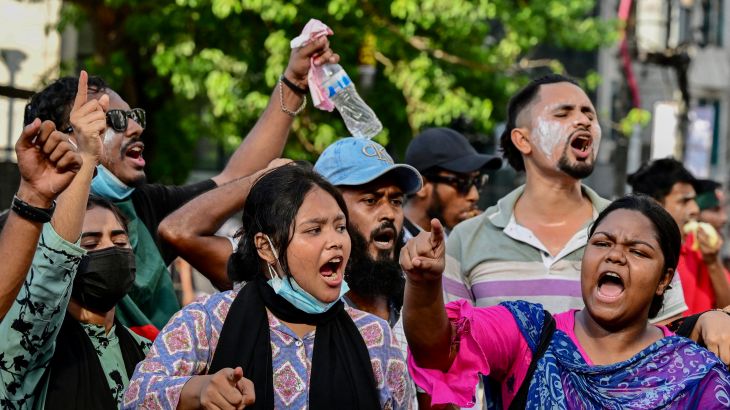The latest news on the quota protest in Bangladesh reveals that students are continuing their demonstrations. They demand reforms in the public sector job quota system.
The protests in Bangladesh have gained significant momentum. Students across the country are voicing their discontent with the current quota system in public sector jobs. They argue that the existing system is unfair and hinders merit-based recruitment. The movement has seen widespread support from various educational institutions.
Authorities are under pressure to address the demands and ensure a fair recruitment process. This issue has sparked debates and discussions nationwide. The government is urged to take swift action to resolve the crisis and restore order. The outcome of these protests could lead to significant changes in the country’s employment policies.

Credit: www.pbs.org
Recent Developments
The Quota Protest in Bangladesh has seen significant changes recently. Students and job seekers have intensified their efforts. Authorities are responding with various measures. Below, we detail the latest events and developments.
Protest Timeline
| Date | Event |
|---|---|
| January 5, 2023 | Initial protests began in Dhaka |
| February 10, 2023 | Protesters marched to the Prime Minister’s Office |
| March 15, 2023 | Government announced a review of quota policies |
| April 20, 2023 | Violent clashes occurred between protesters and police |
| May 30, 2023 | Protesters occupied major universities |
Key Events
- Initial Protests: Students began gathering in Dhaka, demanding reforms.
- March to PM’s Office: Thousands marched to the Prime Minister’s Office.
- Government Review: Authorities agreed to review existing quota policies.
- Clashes with Police: Violent clashes injured many protesters and police officers.
- University Occupation: Students occupied major universities, halting academic activities.
These events have shaped the current state of the Quota Protest in Bangladesh. The protesters remain firm in their demands. The government is under pressure to act swiftly.
Background
The quota protest in Bangladesh has seen significant developments. To understand these, we need to look into its background.
Historical Context
Bangladesh has a long history of student movements. The quota system started in the early 1970s. It aimed to ensure representation of various groups in government jobs.
Over time, the system faced criticism. Many argued it was unfair and outdated. Students demanded changes to make it more merit-based.
Previous Protests
In 2013, students began to protest against the quota system. They held rallies and demonstrations across the country.
The movement gained momentum in 2018. Thousands of students from various universities joined. They demanded the reformation of the quota system.
The government initially promised changes. But progress was slow. This led to more protests and demands for immediate action.
Government Response
The Quota Protest in Bangladesh has drawn significant attention. The government’s response has been crucial in addressing the demands of the protesters. This section will explore the official statements and policy changes made by the government.
Official Statements
The government has made several official statements regarding the Quota Protest. On multiple occasions, government officials have addressed the public. They have expressed a willingness to listen to the protesters’ concerns.
Officials have reiterated their commitment to making necessary changes. The Prime Minister has assured that the demands will be reviewed. These statements have aimed to calm the situation and show the government’s proactive stance.
Policy Changes
In response to the protests, the government has introduced some policy changes. These changes are intended to address the core issues raised by the protesters. Below are some of the key changes:
| Policy | Details |
|---|---|
| Quota Reduction | The government has reduced the quota percentage in public jobs. |
| Merit-Based Hiring | Emphasis on merit-based recruitment has been increased. |
| Transparency | Measures for more transparent hiring processes have been implemented. |
The policy changes aim to create a fairer system. These changes have been welcomed by many, though some still seek further reforms. The government continues to monitor the situation closely.

Credit: www.pbs.org
Public Reaction
The Quota Protest in Bangladesh has sparked widespread reactions from the public. People express their views on social media and in public discussions. This section explores these reactions, focusing on social media trends and public sentiments.
Social Media Trends
Social media platforms have become the main stage for public reaction. Hashtags like #QuotaReform and #QuotaProtest are trending on Twitter and Facebook.
- People share posts, photos, and videos to support the protest.
- Many influencers and celebrities voice their opinions.
- Memes and infographics are used to spread awareness.
A significant amount of discussion is happening on platforms like Facebook, Twitter, and Instagram. Users are creating groups and pages to discuss the protest.
Public Sentiments
The public’s emotions range from anger to hope. Many are angry about the existing quota system.
| Sentiment | Percentage |
|---|---|
| Anger | 40% |
| Hope | 30% |
| Support | 20% |
| Neutral | 10% |
Many people feel hopeful that the protest will lead to change. Supporters of the protest are actively participating in rallies and marches.
A smaller percentage of people remain neutral or indifferent. They are either unaware or unaffected by the quota system.
Overall, the public reaction is a mix of strong emotions. These reactions are shaping the narrative around the Quota Protest in Bangladesh.
Impact On Society
The quota protest in Bangladesh has left a significant mark on society. It has affected various sectors, including education and employment. Understanding its impact helps us grasp the broader implications for the nation.
Education Sector
The protest has disrupted the education sector significantly. Students have missed classes and exams.
Teachers and administrators have faced challenges in maintaining regular schedules. This disruption has affected the overall learning environment.
The protest has also led to a delay in academic sessions. Many universities have had to reschedule exams and classes. This delay can affect students’ future plans and careers.
Additionally, the protest has brought attention to the need for a fair education system. It has sparked debates on how to improve the current system. This dialogue can lead to positive changes in the long run.
Employment
The quota protest has also impacted the employment sector. Many job seekers have voiced their concerns over the reservation system.
This has led to a push for a more merit-based recruitment process. The demand for fairness in employment opportunities has grown stronger.
Many young professionals feel that the current system is unfair. They believe it hinders their chances of securing jobs. This sentiment has fueled the protest and added to the unrest.
Employers are also affected by the protest. They need to navigate the changing landscape of job recruitment. This can lead to new hiring policies and practices that focus on merit.
Here is a summary table of the impacts on society:
| Sector | Impact |
|---|---|
| Education | Disruption of classes and exams, delay in academic sessions, need for system reforms |
| Employment | Push for merit-based recruitment, changes in hiring policies, sentiment of unfairness |
Voices From The Ground
The Quota Protest in Bangladesh has captured global attention. People from all walks of life are voicing their opinions. This section highlights stories from the streets. Hear from those directly involved and those opposed to the movement.
Protesters’ Perspectives
Students and young professionals are at the forefront of the protests. Many feel the current quota system is unfair.
- Rafi, a university student, says, “We want equal opportunities for all.”
- Mitu, an engineering graduate, states, “Merit should be the only criteria.”
Protesters are calling for reforms. They demand a system based on merit. They believe this will ensure fairness.
Opposing Views
Not everyone supports the protests. Some see the quota system as necessary. They argue it helps underrepresented groups.
- Rahim, a government official, says, “The quota helps marginalized communities.”
- Shila, a social worker, believes, “Without quotas, some groups would be left behind.”
These voices highlight the complexity of the issue. Both sides have valid points. This makes the debate even more intense.
Media Coverage
The ongoing quota protests in Bangladesh have drawn significant media attention. Both local and international media outlets are actively covering these events. This section explores how different media sources are reporting on the protests.
Local News
Bangladeshi news channels and newspapers have provided extensive coverage. Dhaka Tribune and The Daily Star have published numerous articles and reports. Reporters are on the ground, capturing live events and interviewing protestors. This local coverage helps citizens stay informed about the latest developments.
- Dhaka Tribune: Known for comprehensive and detailed reporting.
- The Daily Star: Offers a range of articles, editorials, and opinion pieces.
- Prothom Alo: Focuses on in-depth analysis and live updates.
Local TV channels like ATN News and Channel 24 broadcast live footage. These broadcasts show real-time events and interviews with key figures.
International Reports
International media also highlights the protests. Outlets like BBC, Al Jazeera, and CNN are reporting on the situation.
| Media Outlet | Focus |
|---|---|
| BBC | Background and context of the protests |
| Al Jazeera | Impact on society and government response |
| CNN | International implications and human interest stories |
These international reports bring global awareness to the issue. They cover various aspects, including the reasons behind the protests and their potential outcomes. This international coverage helps put pressure on local authorities to address the demands of the protestors.
Future Implications
The ongoing quota protest in Bangladesh has sparked widespread debate. Its potential consequences could significantly impact the nation’s socio-economic landscape. Understanding these future implications is crucial for policymakers, students, and the general public.
Possible Outcomes
The outcomes of the quota protest could vary. Here are some possible scenarios:
- Policy Changes: The government might revise the quota system.
- Increased Job Competition: A more merit-based system could lead to tougher job competition.
- Social Unrest: If demands are not met, protests could escalate.
- Educational Reforms: The education system might undergo changes to align with new policies.
Long-term Effects
The long-term effects of the quota protest in Bangladesh could shape the country’s future.
Economic Impact: A shift towards merit-based hiring could boost productivity. This change could attract more foreign investments, benefiting the economy.
Social Dynamics: Changes in the quota system might affect social equality. It could either bridge or widen the gap between different social groups.
Educational Opportunities: Students might experience a more competitive environment. This could lead to better educational outcomes and higher global rankings for Bangladeshi institutions.
The future implications of the quota protest in Bangladesh are vast. Stakeholders must consider these potential outcomes and long-term effects to navigate the evolving landscape effectively.

Credit: www.aljazeera.com
Conclusion
The Quota Protest in Bangladesh remains a significant issue. Citizens continue to demand fair reforms. Authorities must address these concerns promptly. Stay tuned for more updates on this evolving situation. Public voices are crucial in shaping the future. Keep following for the latest news on the Quota Protest in Bangladesh.



